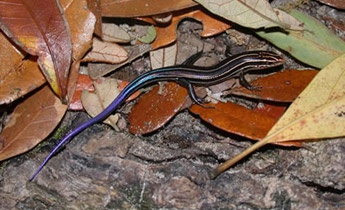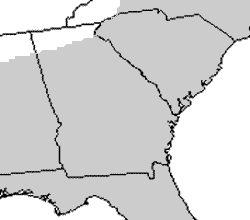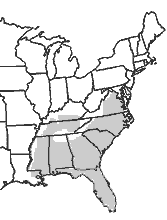Southeastern Five-lined Skink (Eumeces [Plestiodon] inexpectatus)



Photos by Amanda Hurst unless otherwise noted
| Description: 5 – 8.5 in (12.5 – 21.5 cm). Southeastern five-lined skinks are moderately large lizards with short legs and a streamlined body. The body is generally gray, brown, or black, in background color with five white or yellowish stripes (two on each side and one down the center of the back). Young have a bright blue tail while adult males’ stripes may fade and a reddish or orange coloration may develop on the head. This species is very similar in appearance to the five-lined skink and broadhead skink and is usually only identifiable by close examination of the scales: unlike the other two species, southeastern five-lined skinks do not have an enlarged row of scales under the tail. Additionally, broadhead skinks are usually larger and five-lined skink usually inhabit moister habitats.
Range and Habitat: Southeastern five-lined skinks range throughout South Carolina and all but extreme northern Georgia. This species may be found on the ground or in trees and is often common in dry, wooded habitats where there are an abundance of fallen trees and stumps to hide in. Southeastern five-lined skinks prefer drier habitats that the similar five-lined skink, and are particularly common in dry pine forests and in coastal areas. Habits: Southeastern five-lined skinks may be found on the ground or in trees, but are generally less arboreal (tree dwelling) than broadhead skinks. Although sometimes seen in the open, these lizards are most often found beneath logs or under tree bark. When pursued, these lizards generally run for the nearest tree or log and can be quite difficult to capture. Like many other lizards, southeastern five-lined skinks will break off their tails when restrained, distracting the predator and allowing the lizard to escape. Prey: Southeastern five-lined skinks prey on a wide variety of insects, spiders, and other invertebrates. Reproduction: Female southeastern five-lined skinks lay clutches of several eggs in moist soil or rotten logs during the summer and attend the eggs until they hatch. Abundance: Female southeastern five-lined skinks lay clutches of several eggs in moist soil or rotten logs during the summer and attend the eggs until they hatch. Notes: The blue-tailed young of southeastern five-lined, five-lined, and broadhead skinks are widely referred to as “scorpions” and are believed to have a venomous sting. While this belief is completely false, some scientists speculate that these skinks are bad-tasting to many predators. |
